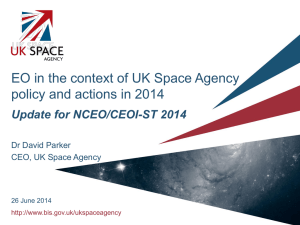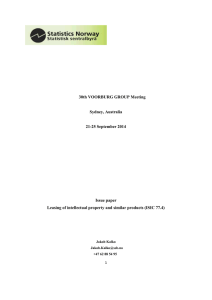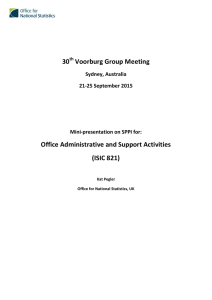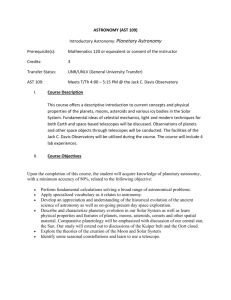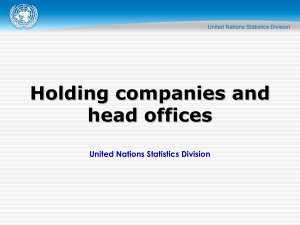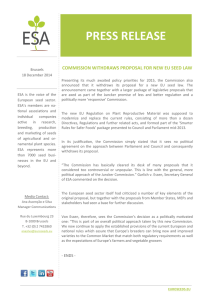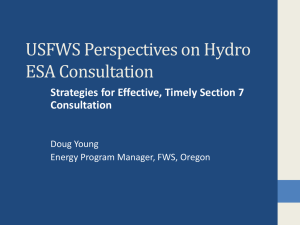Earth Observation - Science & Technology Facilities Council
advertisement
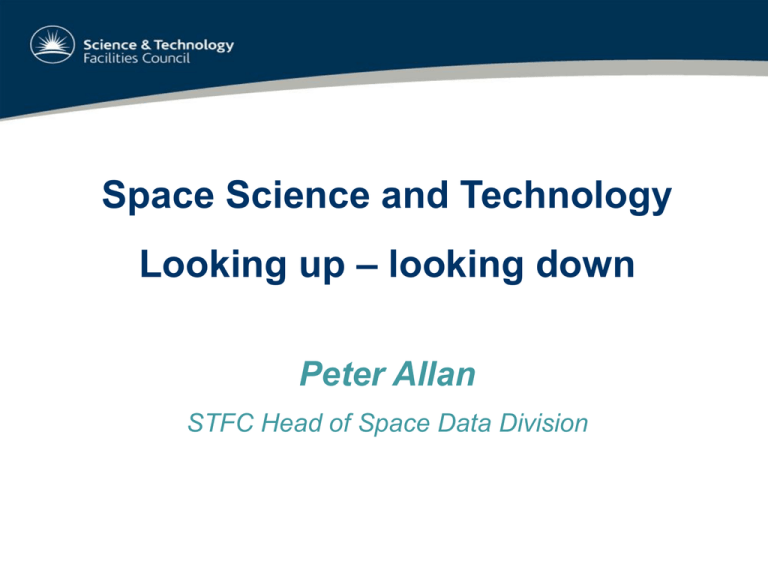
Space Science and Technology Looking up – looking down Peter Allan STFC Head of Space Data Division Chandrayaan MSG-2 LISA VISTA STEREO DoubleStar ATSR Thermal Vac Herschel-Planck TOPSAT Radio Propagation Ground Station Security JWST What do we do in SSTD? • • • • • • Design and build instruments in consortia Develop technology to achieve this Run facilities to enable this Operate data centres on behalf of the science community Operate ground station Provide advice to government What do we do in RAL Space? • • • • • • Design and build instruments in consortia Develop technology to achieve this Run facilities to enable this Operate data centres on behalf of the science community Operate ground station Provide advice to government Funding • 40% STFC → UKSA • 20% NERC → UKSA • 40% non-RC – Over 100 contracts – Often described as “commercial”, but originating with some government, somewhere Science • Astronomy – Solar – Space Plasma – Infra Red / mm wave astronomy • Atmospheric Science – Chemical constituents of the atmosphere – Changes over time, e.g. ozone hole • Earth Observation – Sea surface temperature – Earth radiation budget Sun • • • • SoHO Hinode STEREO Solar Dynamics Observatory Space Plasma • Earth’s magnetic field • Interaction of solar wind with magnetic field • Star Trek sheilds Solar System • • • • Chandrayaan-1 / C1XS Cluster / Double Star Mars Express Cassini / Huygens C1XS spectrum showing well resolved signatures of calcium and iron Mosaic of 3 frames from descent imager Water ice and methane springs Rocks and ice blocks Water and hydrocarbon ice IR astronomy • SPIRE on Herschel Space Observatory • Planck Astronomy Projects • James Webb Space Telescope MIRI (Mid Infra Red Imager) – Far universe, early galaxies, first stars – Action now known to be nearer home • ALMA (Atacama Large Millimetre Array) – Picture of array – Star formation • • • • GAIA LISA Solar Orbiter SPICA Astronomy Projects • James Webb Space Telescope MIRI (Mid Infra Red Imager) – Far universe, early galaxies, first stars – Action now known to be nearer home • ALMA (Atacama Large Millimetre Array) – Picture of array – Star formation • • • • GAIA LISA Solar Orbiter SPICA Earth Observation Projects • Sea surface temperature – ATSR series -> SLSTR Earth Observation Projects • Sea surface temperature – ATSR series -> SLSTR • Earth Radiation Budget – GERB series -> BBR • Rain radar / Lidar – Chilbolton Technology 5 days of GERB data 18 g Atmospheric Science • Atmospheric Chemistry Technology • Design – Mechanical Design – Thermal Design – Electronic Design • Build – Micro-machining • Test – Vacuum test chamber – Cryogenic vibration • Software Facilities • Vacuum test chamber Facilities • Vacuum test chamber • Vibration test – Cryogenic Facilities • Vacuum test chamber • Vibration test – Cryogenic • Ground Station Technology • Concurrent Design Facility Technology • Imaging Systems – Cameras for space – Electronics – Show a picture Data • Data Processing • Data Archives • Long term preservation of data ISIC • International Space Innovation Centre Knowledge Exchange • Work with industry – Giving them things does not work – Generates income too TOPsat Spin Out • Orbital Optics – TOPsat design → Orbital Optics → MDA UK • Terahertz Imaging International Space Innovation Centre (ISIC) A new environment where government, universities and industry can work together to better exploit scientific opportunities and create new technologies, applications and IP that exploits UK, European and Global Space Programmes • ISIC will initially focus on three key areas : – – – Understanding and countering Climate Change Ensuring the Security of space systems and services Exploiting and visualising the data generated by Earth Observation satellites • It will expand to include: – – – • The ISIC will be a modern building complex housing: – – – • Robotics and Exploration Novel Power Sources Integrated Applications Research (Government agencies (e.g. ESA), academics and commercial organisations) Incubation (Space Business Incubator Unit (BIC), funded by ESA, TSB and STFC) Open Innovation and Commercialisation (Including co-location of satellite operations, exploitation and visualisation infrastructure) The ISIC programme will include collaborative R&D projects ISIC (First Phase) • EO Hub – • Security and Resilience Unit – – • – – A scientific facility - providing data visualisation/exploration tools normally out of financial/technical capacity of individual entities. An applications development tool - a means for new players to access the potential of Earth observation for a range of applications An outreach/media facility - a high impact engagement tool to help demonstrate applications and uses of space technology. Business Incubation Centre – – • Expertise on security infrastructure and systems plus appropriate tools and analysis Provision of new secure services for UK government and international partners Visualisation Studio – • ESA compatible end-to-end capability for cost effective satellite operations and data exploitation services Jointly funded by ESA and UK 10 start up companies/ year Concurrent Design Facility – – Interoperable with ESA systems Capability for supporting full mission analysis and design Benefits to Partners • Operational centre fully compatible with ESA standards and interoperable – increased access to European opportunities • Access to broad range of technologies and expertise on the Harwell Campus The Hub and Spokes model extends this access throughout the UK and internationally • Working example of a new approach to innovation across multidisciplinary applications • Facilitates interactions and partnerships between large and small/medium companies • Access to critical mass of expertise in space operations, data handling and data exploitation • Provides a key delivery mechanism for, and input into, the new UKSA
